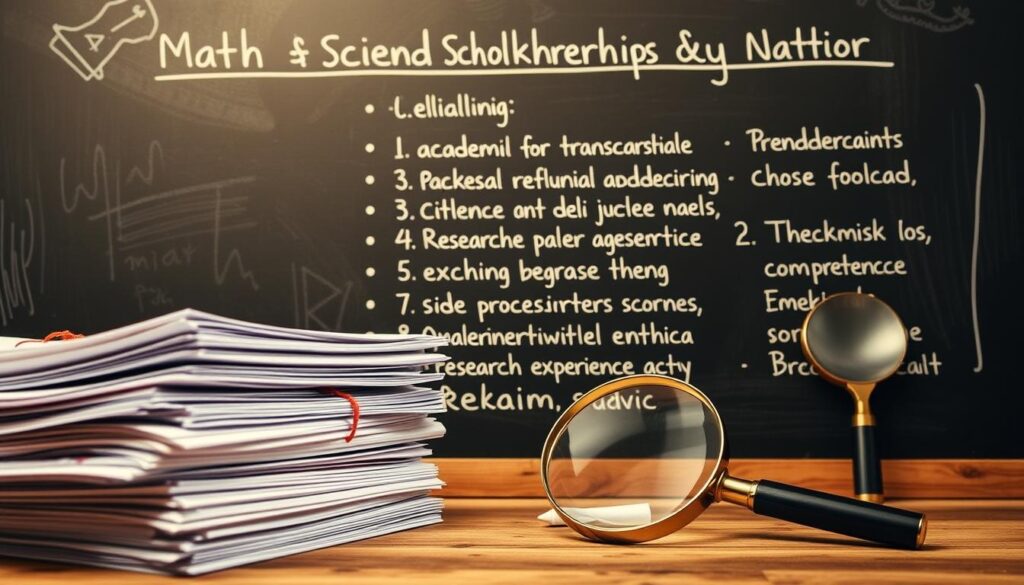Unlock STEM Scholarships for University
Did you know nearly 70% of college graduates are in debt? And it’s even more common for STEM majors. This fact shows why it’s crucial for STEM students to find financial aid. Scholarships for science, technology, engineering, and mathematics can really ease this load.
Take the AMETEK International STEM Scholarship or the Amazon Future Engineer Scholarship, for example. They help students chase their dreams without worrying about loans. Unlocking these scholarships doesn’t just help the students. It also brings fresh ideas and changes to important fields that impact our future.
Key Takeaways
- STEM scholarships significantly reduce student debt graduation rates.
- Major-specific scholarships exist to support and encourage diversity in STEM fields.
- Scholarship programs like AMETEK and Amazon Future Engineer offer vital financial aid.
- Accessing scholarships enhances individual career goals and industry innovation.
- Evaluating eligibility criteria is essential to maximizing opportunities.
- Networking and community engagement can unlock even more scholarship options.
What Are STEM Scholarships and Why Are They Important?
STEM scholarships help students studying science, technology, engineering, and mathematics. They offer financial support for STEM majors. This makes educational costs more manageable and promotes talent and diversity in important fields.
Definition of STEM Scholarships
STEM scholarships are funds given to students in STEM fields. They cover tuition, books, and living expenses. This support is crucial for students’ success and innovation in their academic journeys.
Significance for University Students
For college students, STEM scholarships are a big deal. They offer money help and can boost grades and job chances. With fewer women than men in STEM, these scholarships push for a more diverse workforce.
They tackle financial hurdles. This lets students from all walks of life shine in their studies and future jobs.
Types of STEM Scholarships Available
Understanding the different types of STEM scholarships helps us find the best financial support for education. Each one meets specific needs, making sure skilled students can join their preferred programs. We’ll look into merit-based, need-based, and institutional scholarships, all crucial for securing funding in science and technology fields.
Merit-Based Scholarships
Merit-based scholarships celebrate top academic performance or special talents in extracurricular activities. They look at grades, research achievements, or leadership roles. Getting this type of scholarship can lower the cost of education, allowing students to put more energy into their STEM studies and projects.
Need-Based Scholarships
Need-based scholarships help students who have financial challenges. They check your family’s income and other factors to see if you qualify. This help ensures that talented students can get a good education without being overwhelmed by debt. It’s key to making education in science accessible to more people.
Institutional Scholarships
Institutional scholarships come from colleges and universities themselves. They’re meant to draw in bright students and might cover costs for certain programs, like the STEM Scholars Program at the University of California, Irvine. These scholarships give students critical financial support for their tech education, helping them on their educational path.
How to Find STEM Scholarships
Looking for STEM scholarships can really help us on our educational path. This is especially true for grants in tech fields. There are many tools out there to find college funds for STEM programs that suit our needs.
Resources for Searching Scholarships
We have quite a few ways to find STEM scholarships. College guidance offices often have a list of scholarships available. Also, groups in the science and tech fields may have special scholarships for students.
Online Platforms and Tools
Sites like Scholarships.com have big databases to help search for scholarships. By just giving our interests and qualifications, we can find many chances that fit us right. Tools like Fastweb and Cappex also make finding scholarships easier by matching them to us.
Networking and Community Resources
Talking to people can help us find scholarships. High school counselors and college advisors know a lot about funding chances. Asking groups like the National Science Foundation could also help us find tech grants perfect for STEM students. Don’t forget about local groups either, as they often have scholarships too.
Eligibility Criteria for STEM Scholarships
Getting a college scholarship for math and science majors is a big deal. To succeed, you need to know what scholarships look for. These include things like your grades, if you need financial help, and your activities outside of class.
Common Requirements
STEM scholarships share some basic needs everyone must have. These often are:
- Keeping your grades up, usually above a certain level.
- Taking classes that fit into the STEM category.
- Show that you need financial support with paperwork.
- Sometimes you need to prove you’re active in your community or in STEM clubs.
Major-Specific Criteria
Some scholarships are specific about what you’re studying. They make sure the money helps your exact college and future work plans. They include:
- Scholarships just for engineering students, like those in civil or mechanical fields.
- Chances for computer science students, which is great because tech jobs are booming.
- Money for those studying environmental science or health, tackling important issues.

Preparing Your Application
We need to put a lot of work into our financial aid applications for STEM. This includes getting all our important papers ready and writing a personal story. This story needs to show how much we care about STEM.
Important Application Documents
There are some key things we need for our scholarship applications:
- Official transcripts that show how well we’ve done in school.
- Financial aid forms that tell about our money situation.
- Recommendation letters from teachers or STEM professionals.
Getting these documents early can help make applying easier. It might even increase our chances of getting financial help.
Crafting a Strong Personal Statement
Writing a great personal story is key to our application. It needs to show our love for STEM and our future plans. By focusing on some important parts, we can improve our chance of getting aid for STEM studies.
- Be clear about what we want to do in the future.
- Talk about events or experiences that made us love STEM.
- Show how we plan to make a positive change in STEM.
Sharing our story can really make a difference. It helps scholarship groups see our passion and potential in STEM.
Tips for Writing a Winning Scholarship Essay
Writing a winning scholarship essay is key to getting the funding you need. It’s important to focus on what each scholarship asks for. By making our essays specific, we match what the scholarship committees are looking for. We show off what makes us unique and our achievements. This makes a big difference in getting scholarships for engineering or science.
Tailoring Your Essay to the Scholarship
Every scholarship is different, having its own needs and aims. We must carefully read what they want and include those ideas in our essays. Talking about what excites us about the scholarship can make our application stand out. Showing we understand and care about the scholarship’s goal is key.
Highlighting Relevant Experiences
In our essays, talking about related experiences is crucial. We should talk about internships, projects, or community work that shows our love for STEM. Sharing specific stories and moments paints a clear picture of our success and how we overcome obstacles. This way, we can connect with the committees and show who we really are.
The Role of Recommendation Letters
Recommendation letters are key when applying for financial aid, especially for STEM majors. We should ask people who really know our STEM skills and potential to write them. This could be teachers, mentors, or bosses who’ve seen our work. Their letters help scholarship committees understand our strengths better.
Who to Ask for a Letter
It matters who writes our recommendation letters for scholarships. Ideal people include:
- STEM teachers familiar with our hard work and grades.
- Mentors who understand our STEM goals and dreams.
- Employers at places where we’ve shown our skills through work or internships.
How to Prepare Your Recommenders
We need to give our recommenders everything they need for great letters. Proper prep makes the letters better. Try these steps:
- Tell them about the scholarship’s goals and what it looks for.
- Give them your resume and list of achievements to highlight your strengths.
- Discuss your future career plans so they can personalize their support.
Interview Tips for STEM Scholarship Candidates
Interviews often play a significant role in getting funds for technology education. It’s important to prepare well to show we are the right choice. Learning about common interview questions can help us explain our goals and why we’re passionate.
Common Interview Questions
- What inspired you to pursue a career in STEM?
- How do you plan to contribute to your field after graduation?
- Can you tell us about a challenge you’ve faced in your studies and how you overcame it?
- Why is funding for technology education important to you?
How to Impress Interviewers
To leave a good impression during the interview, there are some key points to focus on. Showing real passion for our field shows we’re committed. Speaking about clear goals shows how the scholarship will help us along our path. Linking our dreams to how we’ll help the industry in the future shows we deserve this support.

How to Manage Multiple Scholarships
Handling many scholarships takes careful planning, especially with university STEM funding. Knowing the rules of each scholarship can greatly help our education journey. It lets us use the funds wisely. It’s also critical to balance our studies and the requirements of these scholarships for our success.
Balancing Funding and Coursework
To stay on top of our grades while managing different scholarships, organizing our time is key. Making a weekly or monthly plan helps split time between studying and meeting scholarship duties. By marking application deadlines and study times on our calendar, we avoid getting overloaded. Since scholarships have their own rules, knowing these helps us follow them and succeed.
Understanding Scholarship Terms and Conditions
Every scholarship has its own set of rules about how we can spend the money and the conditions for its renewal. It’s important to get to know these rules well. Missing a deadline can mean losing funding. For merit-based scholarships, we usually need a certain GPA or to take specific classes. To manage deadlines well, check out scholarship deadlines. This info will help us make the most of our STEM university funding.
| Scholarship Type | Key Requirements | Application Deadlines |
|---|---|---|
| Merit-Based | Maintain GPA, specific coursework | January – March |
| Need-Based | Demonstrate financial need, fill FAFSA | February – March |
| Institutional | Full-time enrollment, academic performance | Varied by institution |
Success Stories: STEM Scholars Who Made It
STEM scholarships change lives for university students. The success stories of those who received them inspire us all. They show how financial aid transformed their studies and launched amazing careers.
Inspirational Testimonials
Kynnedy Brown, studying Neuroscience, is now aiming for her master’s degree and medical school. Griffin McPherson, with a perfect 4.0 GPA in Computer Science, has a job waiting at Salesforce. Their stories show the huge impact of STEM scholarships on their success.
Career Paths and Achievements
STEM scholars take various exciting paths. For example, Jasmine Paz, focusing on Mechanical Engineering, got an internship at Bell Helicopter. Meanwhile, Kayla Thomas is on her way to medical school, thanks to her studies in Biology and Child Development. These stories prove that STEM scholarships offer great research and internship opportunities, leading to bright careers. More success stories like these are available through firsthand accounts of other STEM students.









